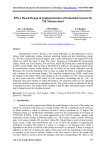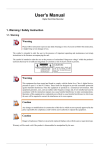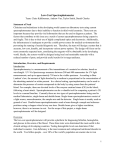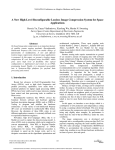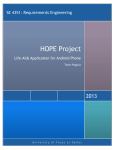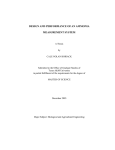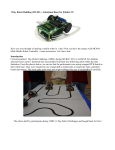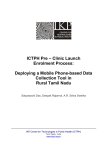Download Remote Location Monitoring of Dam and Risk
Transcript
MIT International Journal of Electronics and Communication Engineering, Vol. 5, No. 1, January 2015, pp. 23–26 ISSN 2230-7672 © MIT Publications 23 Remote Location Monitoring of Dam and Risk Warning System for Flood using GSM Technology Simrat Singh Gill Amit Sharma Assistant Professor E&CEngg.Department, MIT,Moradabad,UttarPradesh,India [email protected] Assistant Professor E&CEngg.Department, MIT,Moradabad,UttarPradesh,India [email protected] Pradeep Kumar Gupta Pushpendra Kumar Singh Assistant Professor E&CEngg.Department, MIT,Moradabad,UttarPradesh,India [email protected] Assistant Professor E&CEngg.Department, MIT,Moradabad,UttarPradesh,India [email protected] ABSTRACT GSM is the most popular technology used in mobile communication.GSM based control system can act as an embedded system that can control and monitor appliances and other devices. There is an automation process by using GSM technology which provides water level indication in various applications like dam, water reservoirs, groundwater monitoring etc. The system allows the user to effectively monitor the water level via mobile by sending commands in the form of SMS and receiving water level status. The type operation to be performed depends on the nature of the SMS sent. The main part includes the development of the system that is capable to detect water level using microcontroller. The sent SMS is stored and polled from the receiver mobile station and then the required control signal is generated and sent to the intermediate hardware that we have designed according to the command received in form of the sent message. The microcontroller is used for processing the network protocols. The system can process the data that has been collected based on the water level. Though this technology is initially meant for dam monitoring, it can be easily adapted to other fields. I. INTRODUCTION the implementation of this project, it will reduce the number Atleast49,000existinglargedamsarefragmentingnearlyhalf of workers involved during a work in progress. The use of this oftheworld’srivers.Adamhaslargecapacity,anditisusually toolisnotlimitedtodam,butitcanbeappliedtootherfields. kept partially full. So, when it rains heavily or there is a big snow melt-off, a large amount of water can be captured in the dam and releasedslowlydownstream.Ifthedamhadn’tbeenthere,ahuge amountofwatercouldhaverusheddowntheriversandflooded downstream. Dams can stabilize the water levels of inland lakes and seas. When water increases to a dangerous level and is not monitored by the authorities, and then dam failure can cause potentialcatastrophicdamagetolifeandproperty.However,this condition can be prevented if the authorities always know the current status of the water level. Therefore a technology needs to be developed to tackle this problem and making the system more organized. Therefore, designing of water level indicator is one of the technological advancement to transmit data and send it to authority for controlling. The systems also give an alert to authority to take immediate action if water level increases to dangerous level. The system can be applied at the river-banks, low-lying areas, dam and the village far from town and also can be used for industrial sector. It is an effective method to transmit, analyze, manage and give a feedback. The authorized person will take an immediate action to monitor the water level[1].With Fig. 1:BlockDiagramofWaterLevelIndicatorBasedOnGSM MIT International Journal of Electronics and Communication Engineering, Vol. 5, No. 1, January 2015, pp. 23–26 ISSN 2230-7672 © MIT Publications II. FA C TO R S I N F L U E N C I N G H A R D WA R E DEVELOPMENT Variousfactorsplayanimportantroletoadaptacompletesystem based on a particular technology. • Time: When water rises above safe region then this is thegoldenperiodtostartthefloodmitigationplans.The duration taken from alert till the information is send to responsible authorities is very important and should be done in shortest time possible. Every second is precious for the rescue team to help and save the victims. 24 tothemobilephones.GSMmodemscanbeaquick andefficientwaytosendandreceiveSMS,becausea specialsubscriptiontoanSMSserviceproviderisnot required.Toperformthesetasks,aGSMmodemmust supportan“extendedATcommandset”forsending/ receivingSMSmessages[3]. • Themaindifferencebetweenthedial-upmodemand GSMmodem is that a dial-upmodem sendsand receivesdatathroughafixedtelephonelinewhilea wireless modem sends and receives data through radio waves. • Cost: Device cost and maintenance cost plays crucial role (b) ZIGBEE: to implement the hardware. If the cost of device is high, • Itisaspecificationforasuiteofhighlevelcommuitwillberestrictedtolimitedareas.Maintenancecostis nication protocols using small and low power digital a long term investment until the device is in use. radiosbasedonIEEE802standardforpersonalarea • Plan: During calamity the authorities have to make wise network. decisions to save victims. The authorities have to plan • Thesedevicesareoftenusedinmeshnetworkform according to time and resources available to them. to transmit data over long distances and passing data through intermediate devices to reach large distance. • This allows ZigBee networks to be formed ad-hoc, with no centralized control or high-power transmitter/ receiver able to reach all of the devices. • Itistargetedatapplicationsthatrequirealowdatarate, long battery life, and secure networking. • Ithasadefinedrateof250kbit/s,bestsuitedforperiodic or intermittent data or a single signal transmission from a sensor or input device. • Applicationsincludewirelesslightswitches,electrical meterswithin-home-displays, trafficmanagement systems, and other consumer and industrial equipment that requires short-range wireless transfer of data at relatively low rates. The technology defined by the ZigBeespecificationisintendedtobesimplerandless expensive than other WPANs, such as Bluetooth or Wi-Fi. • ZigBeenodes can go from sleep to active mode in 30msorless,thelatencycanbelowanddevicescan be responsive, particularly comparedto Bluetooth wake-up delays, which are typically around three seconds.BecauseZigBeenodescansleepmostofthe time, average power consumption can be low, resulting in long battery life. Fig. 2: Important Factors 2.1 Technologies Available (A). GLOBALSYSTEMFORMOBILE(GSM): • It is a standardset developedby ETSI(European Telecommunication StandardInstitute)to describe protocols for second generation digital cellular networks used by mobile. • GSM was expanded o ver time to include d ata communications, first by circuit switched transport, then packet data transport via GPRS(GeneralPacket RadioServices)andEDGE(EnhancedDataratesfor GSMEvolutionorEGPRS). • A GSM modem is a specialized type of modem which acceptsaSIMcard,andoperatesoverasubscription to a mobile operator, just like a mobile phone. • GSMmodemsareacosteffectivesolutionforreceiving SMSmessages,becausethesenderispayingforthe messagedelivery.GSMmodemispreferabletoGSM phone due to the disadvantage of the charging related • ZigBeedevicesareofthreetypes: • ZigBeeCo-ordinator(ZC):Themostcapabledevice, the Co-ordinator forms the root of the network tree and might bridge to other networks. There is exactly oneZigBeeCo-ordinatorineachnetworksinceitis the device that started the network originally .It stores information about the network, including acting as the TrustCentre&repositoryforsecuritykeys. • ZigBeeRouter(ZR):Inarunningapplicationfunction, a ZigBee Router can act as an intermediate router, passing on data from other devices. MIT International Journal of Electronics and Communication Engineering, Vol. 5, No. 1, January 2015, pp. 23–26 ISSN 2230-7672 © MIT Publications 25 • ZigBeeEndDevice(ZED):ZEDcontainsjustenough functionality to communicate to the parent node and cannot relay data from other devices. Hence this relationshipallowsthenodetobeasleepasignificant amount of the time thereby giving long battery life. A ZEDrequiresthe least amount of memoryand therefore can be less expensive to manufacture than a ZRorZC. Fig. 4: Level Distribution Factors Fig. 3:FlowDiagramofWaterLevelIndicatorUsingGSM III. DESIGN AND IMPLEMENTATION The first stage of designing involves a water level sensor that is made for sensing water level accurately. If water level is at moderate or high level then sensors sends message to the microcontroller otherwise it senses the water level again.Microcontrolleris usedto control the overall system automatically that reduces the design and control complexity. Microcontrollertakesinputfromthesensorunitandsendsthe signaltotheGSMmodemafterprocessingdata.GSMmodem thensendsthemessagetotheuser’sphone.Theuserthentakes appropriate action and performs other controlled operations. Conventional system GSMbased system Reception of water level alerts No Automatic Display warning signs No Automatic Cost of installation Daily basis Low cost IV. CONCLUSION Failure of dams can be devastating to life and property. Therefore asolutionforthisproblemispresentedinthispaper.Byusing a mobile phone one can monitor the water level in dams so that water level above high risk level can be alerted immediately by MIT International Journal of Electronics and Communication Engineering, Vol. 5, No. 1, January 2015, pp. 23–26 ISSN 2230-7672 © MIT Publications the use of remote measurements. This makes it convenient for the user and helps in reducing danger caused by dam failures. This paper can be used as a reference for realizing other projects 1. such as weather forecasting, temperature updates, device synchronization,etc[5].Henceitjustifiesthatanydevicecanbe controlled remotely. This system can be linked to relays which 2. can automatically control the switching of gates by allowing 3. excesswatertoflow. V. FUTURE WORKS Sensors are important elements in the system. Further studies on wireless sensor technology will be best to replace the current sensors. Precise and accurate detection of water level will improve the data collection system for the monitoring station. Thefloodalertinformation’scanbedisplayedondisplayboards for road users and for safety reasons could be placed at strategic locations. A possible means of power supply for the centralized control unit can be solar cells. The use of solar energy will be cheaper.TheGSMtechnologycanbereplacedbyZIGBEE. 26 REFERENCES “Microcontroller B ased Water Level Indicator UsingGSM Mode m : De si gn a nd Appl i c a t i on” Me l at y A m i rruddi n, NurhakimahM.Mukhtar,HanaA.Halim,NurS.NoorpiSchool of Electrical Systems Engineering UniversityMalaysiaPerlis(UniMAP)Perlis,Malaysia. “Floodlevel indicatorandrisk warni ngsyst em forremote locationmoni tori ngu si ngflood obse rvat ory s yst em” Siva KumarSubramaniam1,VigneswaraRaoGannapathy2,Sivarao Subramonian3andAbdulHamidHamidon. 4. ATCommandsInterfaceGuide,Wavecom,2002,pp.2-13. 5. “Microcontroller BasedAutomatedWaterLevelSensingand Controlling:DesignandImplementationIssue”S.M.KhalidReza, ShahAhsanuzzamanMd.Tariq,andS.M.MohsinReza. 6. “GSMbased controlsystem”http://chipscity.com/downloads/ projects/gsm%20based%20control%20system.pdf. 7. Zelio Logic 2 Smart Relay User’s Manual, Schneider Electric Com.,2002,pp.17-38. 8. SitiYuhaniz,TanyaVladimirovaandScottGleason,AnIntelligent Decision-Making SystemforFloodMonitoring fromSpace, ECSISSymposiumon Bio-inspired, Learningand Intelligent SystemsforSecurity,pp.65-71.





